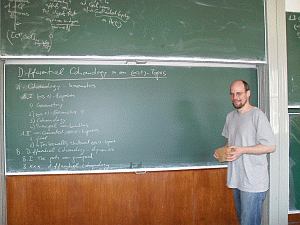Higher Structures in Göttingen IV
Posted by Urs Schreiber
guest post by Christoph Wockel
Dear all,
we cordially invite you to participate the CRCG Workshop “Higher Structures in Topology and Geometry IV”, which will take place June 2-4 at the Göttingen Mathematics Institute (Germany). Main speakers will be
- Ezra Getzler (Northwestern)
- Birgit Richter (Hamburg)
- Urs Schreiber (Utrecht)
- Christoph Schweigert (Hamburg)
In addition, there will be a minor amount of talks given by PhD students and postdocs. For additional information you may consult the
Best wishes,
Christoph Wockel (on behalf of the organisers Giorgio Trentinaglia and Chenchang Zhu)
On this blog we had also reported on


Re: Higher Structures in Göttingen IV
first talk: Birgit Richter on Richter-Baas-Dundas-Rognes 2-vector bundles:
BDR 2-vector bundles
(rough first notes right after the talk)